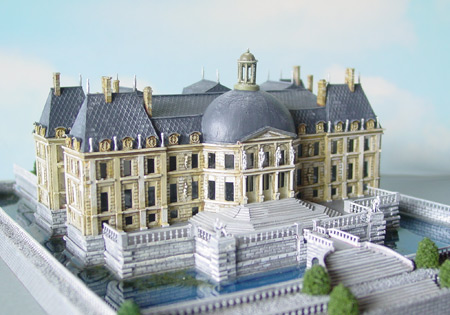
CHATEAU de VAUX-LE-VICOMTE . Maincy, France . 7" x 9" x 3.5" Tall

CHATEAU de VAUX-LE-VICOMTE . Maincy, France . 7" x 9" x 3.5" Tall
|
The Chateau de Vaux-le-Vicomte is a Baroque chateau locaed in Maincy, 55 km from Paris. It was built from 1658 to 1661 for Nicolas Fouquet, the superintendent of finances of Louis XIV. When finished, it was the finest chateau and garden in France. The architect was Louis Le Vau, and the landscape architect was Andre Le Notre. Under Fouquet the chateau became a great center of fine feasts, literature and arts. Everything was lavish, refined, and dazzling to behold. So much so that the King had Fouquet arrested shortly after a famous fete in 1661, believing him to misappropriate public funds. He was imprisoned for life and his wife was exiled. Then the King seized and confiscated the tapestries, statues and the orange trees and sent forth a team of artists and architects to design a much larger project than Vaux-le-Vicomte - Versailles. Like many chateau in France, Vaux is surrounded on three sides by a rectangular moat. The structure is symmetrical with slightly projecting central and end pavillions. It is dominated by the central oval salon which rises the full height of the house, under an oval dome. Madame Fouquet recovered her property 10 years after being exiled and retired there with her eldest son. After her husband's and son's death she put the chateau up for sale in 1705. The Marechal de Villars bought it even though he'd never seen the place. He sold it in 1764 to the Duke of Praslin, whose descendants owned it for over a century. In 1875 Alfred Sommier acquired Vaux-le-Vicomte at a public auction. It was empty and had fallen into ruin and the famous gardens were totally overgrown. By the time of Sommier's death in 1908 the chateau and the gardens had recovered their original appearance. His son and daughter-in-law completed the task. Today, his descendants continue to work on the preservation of Vaux-le-Vicomte. Vaux-le-Vicomte
was one of the most influential works built in Europe in the mid-17th
century. It was the finest house in France and marked a
collaboration, for the first time, of artists, architects, and designers,
creating a new order that is now called the "Louis XIV Style". Although the
chateau remains a private property, it welcomes visitors for tours of the
structure and the extensive gardens. |
| CLOSE THIS PAGE |